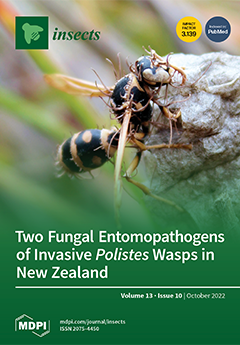Climate change, especially climate extremes, can increase the uncertainty of locust outbreaks. The Italian locust (
Calliptamus italicus (Linnaeus, 1758)), Asian migratory locust (
Locusta migratoria migratoria Linnaeus, 1758), and Siberian locust (
Gomphocerus sibiricus (Linnaeus, 1767)) are common pests widely distributed in
[...] Read more.
Climate change, especially climate extremes, can increase the uncertainty of locust outbreaks. The Italian locust (
Calliptamus italicus (Linnaeus, 1758)), Asian migratory locust (
Locusta migratoria migratoria Linnaeus, 1758), and Siberian locust (
Gomphocerus sibiricus (Linnaeus, 1767)) are common pests widely distributed in the semidesert grasslands of Central Asia and its surrounding regions. Predicting the geographic distribution changes and future habitats of locusts in the context of climate warming is essential to effectively prevent large and sudden locust outbreaks. In this study, the optimized maximum entropy (MaxEnt) model, employing a combination of climatic, soil, and topographic factors, was used to predict the potential fitness areas of typical locusts in the 2030s and 2050s, assuming four shared socioeconomic pathways (SSP126, SSP245, SSP370, and SSP585) in the CMIP6 model. Modeling results showed that the mean area under the curve (AUC) and true statistical skill (TSS) of the MaxEnt model reached 0.933 and 0.7651, respectively, indicating that the model exhibited good prediction performance. Our results showed that soil surface sand content, slope, mean precipitation during the hottest season, and precipitation seasonality were the key environmental variables affecting locust distribution in the region. The three locust species were mainly distributed in the upstream region of the Irtysh River, the Alatao Mountain region, the northern slopes of the Tianshan Mountains, around Sayram Lake, the eastern part of the Alakol Lake region, the Tekes River region, the western part of Ulungur Lake, the Ili River, and the upstream region of the Tarim River. According to several climate projections, the area of potential habitat for the three most common locust species will decrease by 3.9 × 10
4–4.6 × 10
4 km
2 by the 2030s and by 6.4 × 10
4–10.6 × 10
4 km
2 by the 2050s. As the climate becomes more extreme, the suitable area will shrink, but the highly suitable area will expand; thus, the risk of infestation should be taken seriously. Our study present a timely investigation to add to extensive literature currently appearing regarding the myriad ways climate change may affect species. While this naturally details a limited range of taxa, methods and potential impacts may be more broadly applicable to other locust species.
Full article






